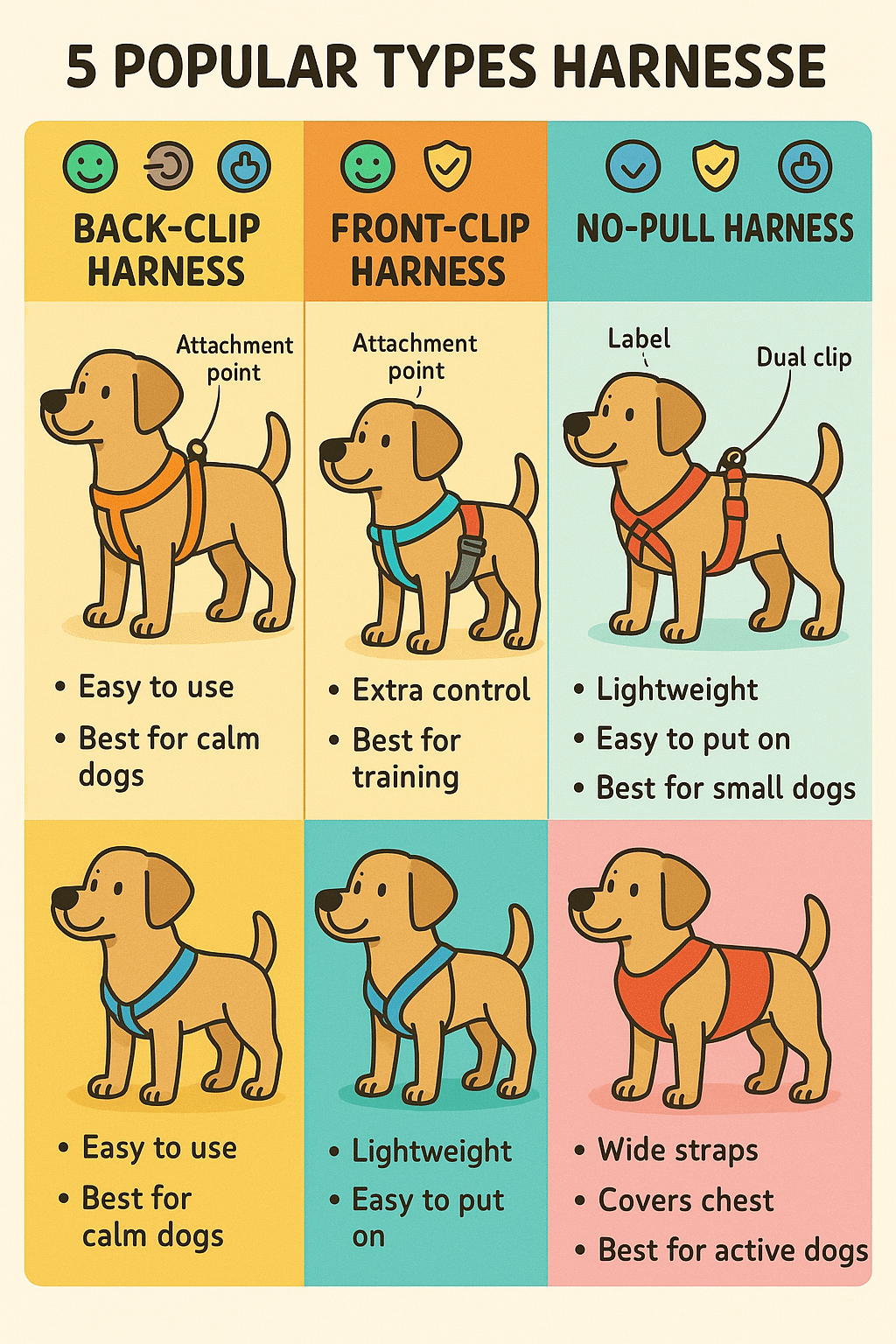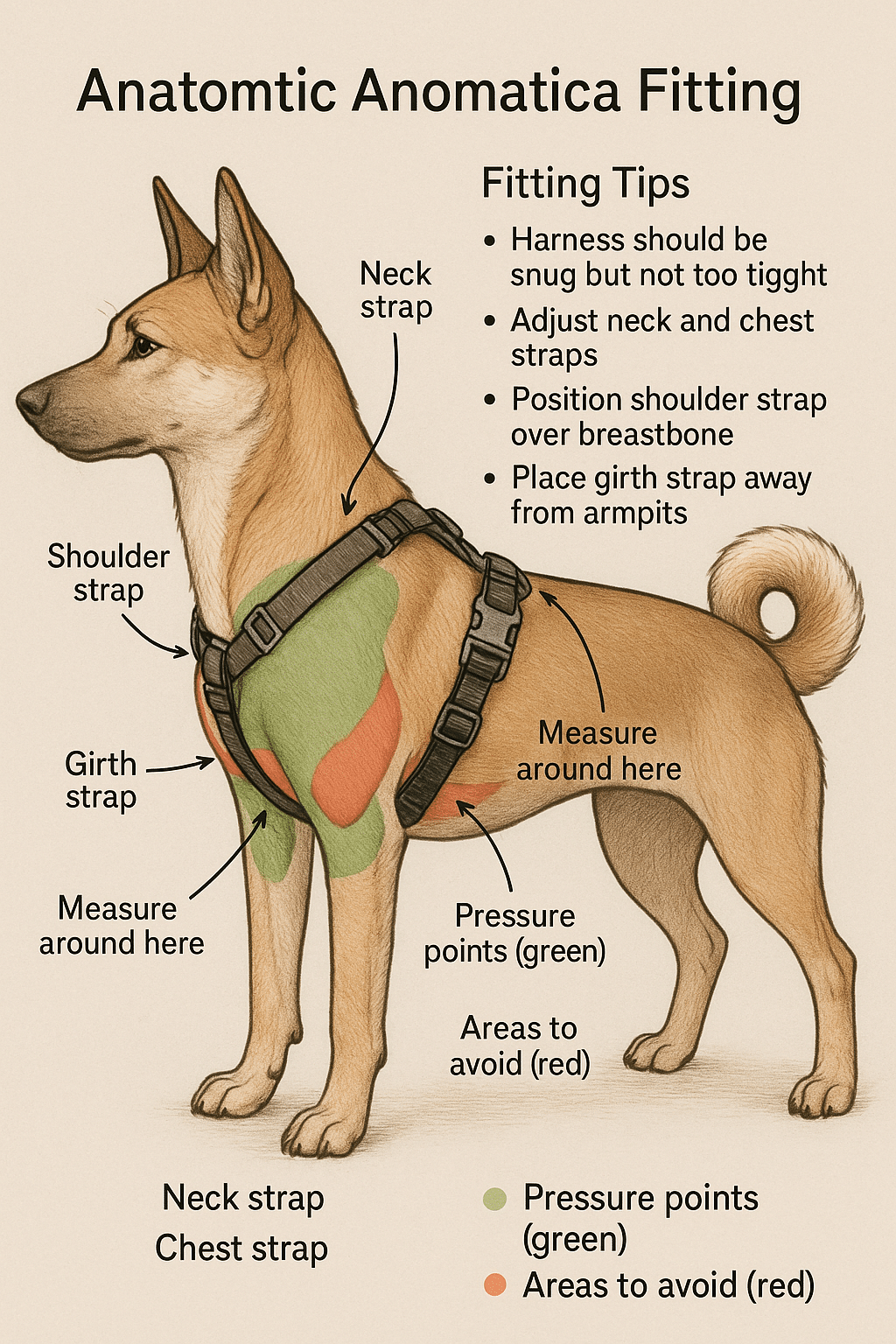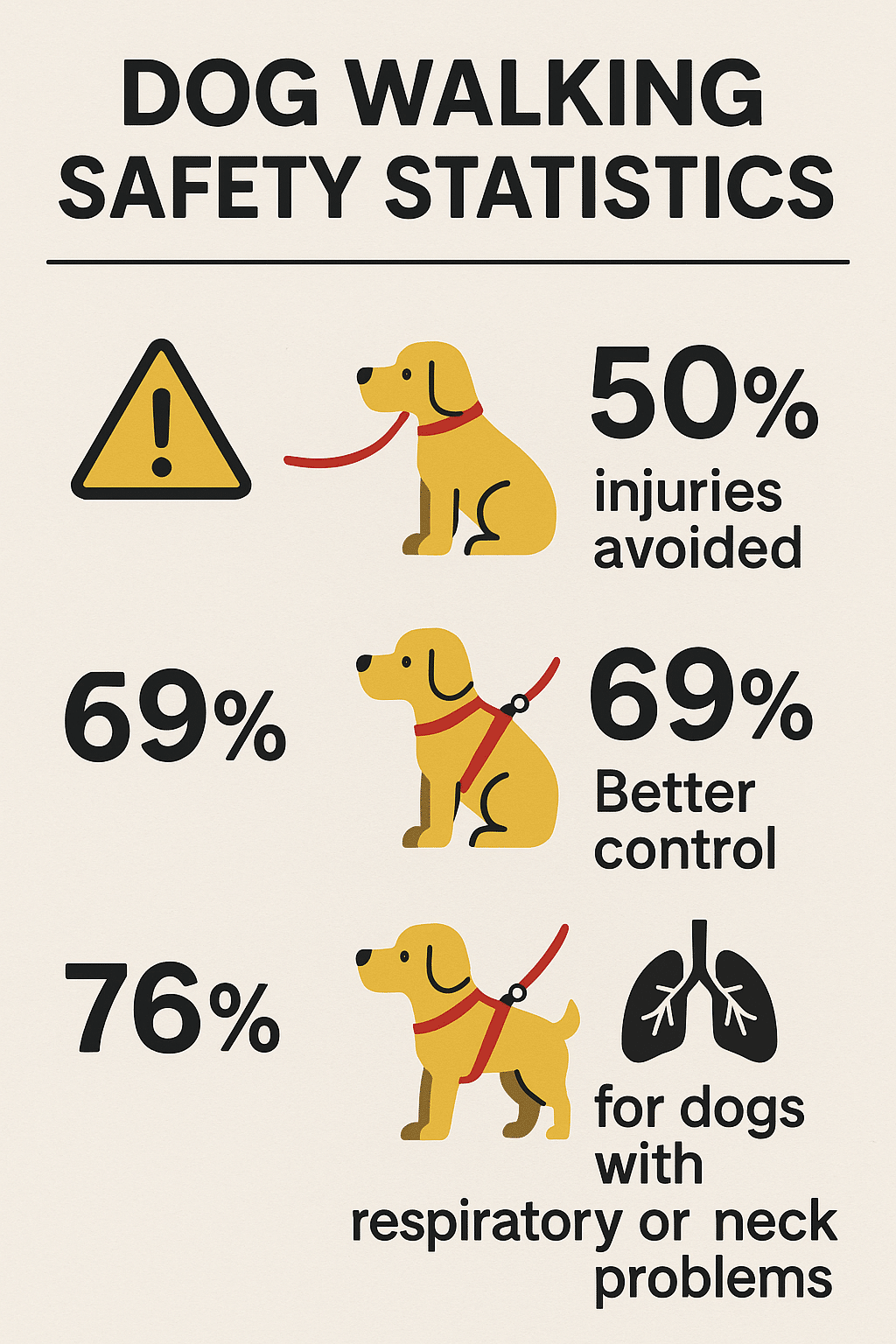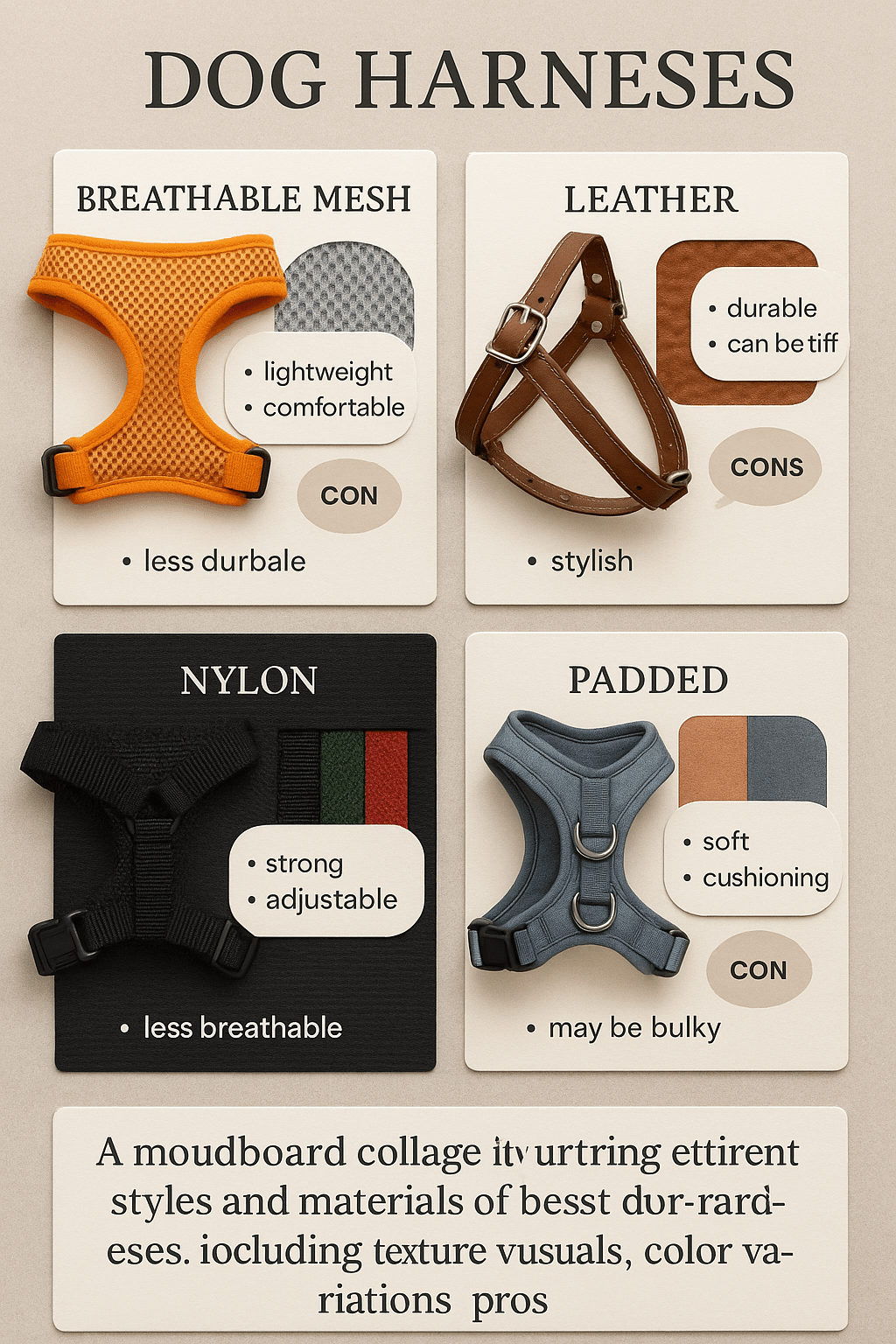When it comes to walking your furry companion, choosing the best dog harness can make all the difference. After all, a harness isn’t just a tool—it’s an essential part of your dog’s comfort, safety, and training routine. Whether you’re a new puppy owner, managing a strong puller on leash, or simply want a more ergonomic option than a collar, the right harness ensures enjoyable and controlled walks while protecting your dog’s delicate anatomy. In this comprehensive guide, I’ll walk you through everything you need to know about dog harnesses—types, benefits, features to watch for, and detailed reviews of the seven best dog harnesses on the market today. Plus, you’ll learn how to pick the perfect fit and take care of your harness to keep it lasting for years.
Let’s dive into uncovering the best dog harness that suits your pet’s unique needs, so you can head out confidently together, rain or shine!
Understanding Dog Harnesses: Types and Benefits

Choosing the right dog harness starts with understanding what options exist and how they work. As a pet owner, I’ve seen how different harness styles can impact a dog’s comfort and behavior drastically.
Harness Styles: Vest, No-Pull, Chest Plate, and Balance
Dog harnesses generally fall into a few common styles:
-
Vest Harness: These harnesses wrap around the dog’s torso like a soft vest, often with breathable mesh and padding for comfort. They’re easy to put on and distribute pressure evenly—great for daily walks and small or nervous dogs.
-
No-Pull Harness: Designed specifically to discourage pulling, no-pull harnesses feature a front leash attachment (usually on the chest) that redirects the dog’s momentum. Models like the PetSafe Easy Walk Harness employ a patented Martingale loop that gently tightens to deter pulling behavior.
-
Chest Plate Harness: These harnesses incorporate a rigid or semi-rigid plate on the chest, such as the EzyDog Chest Plate Harness, providing ergonomic fit and better control. This design helps disperse force and protects the sternum and trachea.
-
Balance Harness: The Blue-9 Balance Harness is a standout example with its six-point adjustable system, which offers customized fitting tailored to the dog’s body shape, maximizing comfort and reducing the risk of injury.
Each style serves a particular walking and training purpose. For example, no-pull harnesses excel for dogs that tend to lunge ahead, while vest harnesses are ideal for everyday use and puppies.
Benefits of Using a Harness Over a Collar for Your Dog
You might wonder why a harness is worth switching to, instead of sticking with the classic collar and leash combo. Here’s why I prefer harnesses:
-
Reduced Neck Strain: Unlike collars that concentrate pressure on the neck, especially when dogs pull, harnesses disperse force across the chest and shoulders, protecting the delicate trachea and preventing injury.
-
Enhanced Control: Harnesses with multiple leash attachment points, such as front and back rings, give you better directional control—critical for training and managing dogs that tend to pull or dart suddenly.
-
Safety for Specific Dogs: Dogs with respiratory issues, brachycephalic breeds (like Bulldogs or Pugs), and seniors benefit immensely from harnesses, as collars can exacerbate breathing problems and cause discomfort.
-
Preventing Escape: Some more fitted harnesses make it difficult for dogs to slip out, offering peace of mind during outdoor adventures.
-
Versatile Use: Harnesses come with features like car seat belt attachments (e.g., the Kurgo Tru-Fit Smart Harness), infrared reflective strips for night visibility, and padded areas for comfort—all adding convenience and safety.
In my own experience working with many dogs, using a harness has not only improved their walking behavior but enhanced their overall well-being by minimizing physical stress.
How to Choose the Best Dog Harness for Your Pet

Not all harnesses are one-size-fits-all. Selecting the right harness demands attention to a few key factors related to your dog’s unique profile and lifestyle.
Assessing Your Dog’s Size, Breed, and Behavior
Start by evaluating:
-
Size and Build: Small toy breeds will need lightweight harnesses, while large, muscular dogs require robust and durable models that can handle their strength, such as the Ruffwear Front Range Harness.
-
Breed Characteristics: Short-nosed breeds may benefit from no-pull or chest plate harnesses that avoid neck constriction. Active breeds likely appreciate breathable, padded, and reflective harnesses for comfort and safety during long exercises or hiking.
-
Behavioral Tendencies: If your dog pulls on the leash, look into no-pull designs with front leash attachment points for better control. If your dog is fearful or prone to slipping out of gear, a snug vest or balance harness that’s adjustable can help.
Importance of Adjustable Straps and Proper Fit
A harness is only as good as its fit. Adjustable straps around the neck, chest, and girth are essential. For example, the Kurgo Tru-Fit Smart Harness offers five adjustment points, which provide a near-custom adjustment for a snug yet comfortable fit. Similarly, the Blue-9 Balance Harness allows six adjustment points, promoting an ergonomic, injury-free experience.
Ill-fitting harnesses cause discomfort, chafing, or become escape routes for your dog. Always follow the specific sizing charts provided by manufacturers and measure your dog accurately (more tips in the measuring section below). When in doubt, prefer slightly looser to allow breathing room but with enough security to prevent slipping.
Materials and Durability: What to Look For
When it comes to durability and comfort, the materials count:
-
Soft, Breathable Fabrics: Harnesses like the Ruffwear Front Range use padded polyester and breathable mesh, ideal for everyday wear and outdoor adventures.
-
Reinforced Stitching and Hardware: Look for rust-proof welded D-rings and reinforced buckles (plastic or metal) that withstand pulling and regular use, such as those on the EzyDog Chest Plate Harness.
-
Water Resistance: Some harnesses have waterproof qualities, which is helpful for dogs that love the outdoors or swim. Reflective materials also add visibility on nighttime walks.
-
Ease of Cleaning: Removable, washable harnesses save you time and keep your dog comfortable. The Blue-9 Balance Harness utilizing soft-touch nylon is durable yet machine-washable.
Safety Features: Reflective Strips and Leash Attachment Points
Safety is paramount. Consider these features:
-
Reflective Strips: Especially for early morning or late evening walks, reflective trims enhance visibility, as seen on the Rabbitgoo No-Pull Dog Harness and Ruffwear Front Range Harness.
-
Multiple Leash Attachments: Front and back attachment points enable better control and training opportunities. Front clips promote no-pull walking; back clips are suited for general walks.
-
Seat Belt Tethers: Harnesses like the Kurgo Tru-Fit Smart Harness and EzyDog Chest Plate Harness include seat belt tethers to secure your dog in the car, a crucial safety measure during travel. Note: Some harnesses are not crash-certified, so check specifics before relying on them fully.
-
Quick-Release Buckles: Easy to use yet secure buckles reduce stress during harnessing and removal, vital for senior dogs or anxious pets.
In-Depth Reviews of the 7 Best Dog Harnesses

Here’s a detailed exploration of each of the top-rated harnesses, spotlighting features, pros, cons, and best use cases.
Kurgo Tru-Fit Smart Dog Walking Harness: Versatility for Walks and Car Travel
The Kurgo Tru-Fit Smart Harness shines as a multi-functional option. With its five adjustable points and padded chest plate, it provides lasting comfort even for active or strong dogs. The dual leash attachment points allow both no-pull training and regular walks. An included 10-inch seat belt tether means this harness easily doubles for secure car travel, although owners should note it’s not crash-tested.
Pros:
- Versatile for walking and travel
- Multiple adjustment points for a custom fit
- Padded chest plate protects against trachea stress
- Comfortable and breathable material
Cons:
- Not crash-tested for car safety
- Quick-release plastic buckles may wear with heavy use
Best for: Owners seeking a flexible harness for walking and car rides, especially mid-sized dogs.
Ruffwear Front Range Harness: Durable Comfort and Visibility for Active Dogs
Famed for rugged durability and thoughtful design, the Ruffwear Front Range features two leash attachment points—a coated aluminum ring for back-leash walking and a front webbing loop for no-pull control. Its padded straps, reflective trim, and integrated light loop make it outstanding for visibility. The hidden ID pocket adds convenience.
Pros:
- Robust and well-padded
- Reflective features for night safety
- Ideal for active, outdoor dogs
- Padded for all-day comfort
Cons:
- Slightly higher price point
- Some owners find sizing runs small; careful measuring required
Best for: Outdoor enthusiasts with energetic dogs needing durability and visibility.
Julius-K9 IDC Powerharness: Ergonomic Design for Urban Walks
The Julius-K9 IDC Powerharness is known for its sleek, ergonomic design that affords owners professional control during urban walks. Its chest strap runs parallel to the leash line, distributing force evenly, making it excellent for dogs that pull. The wide chest strap and optional padding ensure dog comfort, while the harness is highly durable.
Pros:
- Durable, easy to clean
- Ergonomic power distribution
- Simple on-and-off with heavy-duty clips
- Multiple colors and customization available
Cons:
- Bulkier design may not suit very small dogs
- No built-in leash attachments on the front for no-pull training (depends on version)
Best for: City dog walkers needing control and minimal bulk.
PetSafe Easy Walk Harness: Proven No-Pull Solution for Training
The PetSafe Easy Walk Harness stands out for its patented no-pull Martingale loop that gently discourages pulling by applying pressure on the shoulders rather than the neck. Its simple design and breathable fabric make it comfortable for daily use.
Pros:
- Effective no-pull design
- Breathable and lightweight
- Affordable price
- Multiple sizes available for different breeds
Cons:
- Not padded for long-term comfort in some dogs
- May take training time to get dog used to chest pressure
Best for: Owners seeking a budget-friendly no-pull harness for leash training puppies or adults.
EzyDog Chest Plate Harness: Ergonomic Fit with Travel Safety
Featuring an EVA foam chest plate, the EzyDog harness molds to your dog’s chest, providing both comfort and control. Reflective stitching enhances nighttime visibility, while a rust-proof welded D-ring adds reliability. Like the Kurgo, it includes a seat belt car restraint for travel safety.
Pros:
- Ergonomic foam chest plate
- Reflective details increase safety
- Well-suited for car travel
- Available in multiple colors and sizes
Cons:
- Slightly less breathable material
- Some users report buckles less easy to adjust than others
Best for: Dogs requiring enhanced chest support and owners traveling frequently by car.
Blue-9 Balance Harness: Six-Point Adjustment for Customized Fit
The Blue-9 Balance Harness is a stellar choice for those prioritizing precise fit and movement freedom. With six adjustment points and buckle neck closure, it’s perfect for sensitive dogs uneasy about head-over harness designs. The soft-touch nylon is durable yet comfortable. Multiple leash attachments allow training flexibility.
Pros:
- Highly customizable fit
- Washable and durable
- Ideal for dogs that hate harnesses over the head
- Front and back leash rings included
Cons:
- Pricier than basic harnesses
- More time needed to adjust perfectly
Best for: Sensitive or anxious dogs requiring expert fit and comfort.
Rabbitgoo No-Pull Dog Harness: Effective Pull Control with Comfort and Reflective Safety
Rabbitgoo’s harness incorporates four adjustable straps for a snug fit, while the padded chest area prevents chafing. Reflective strips keep your dog visible, and the two leash rings offer no-pull control by attaching the leash upfront or regular walking on the back. Easy to use with quick-release buckles, this harness appeals to many owners looking to reduce pulling.
Pros:
- No-pull design gently redirects dogs
- Padded for comfort on extended walks
- Reflective safety strips
- Affordable and easy to use
Cons:
- Can run small—measure carefully
- Quality control varies with batches
Best for: Budget-conscious owners needing no-pull control without sacrificing comfort.
Specialized Needs: Best Harnesses for Puppies, Small Dogs, and Large Breeds

Harness needs vary based on your dog’s development and size.
Best Harnesses for Puppy Leash Training
For puppies, comfort and ease of use are vital. The PetSafe Easy Walk Harness is excellent here, offering gentle no-pull control without causing harm to their developing bodies. Additionally, the Rabbitgoo No-Pull Harness is adjustable enough to grow with your pup.
Harnesses Suited for Small or Toy Breeds
Smaller breeds benefit from lightweight, flexible harnesses like the Kurgo Tru-Fit Smart Harness, which provides multiple adjustments without bulk. The Julius-K9 IDC Powerharness offers smaller sizes, ensuring a snug, safe fit for tiny dogs.
Durable and Supportive Harnesses for Large and Active Dogs
For big dogs, durability and support are paramount. The Ruffwear Front Range Harness and Blue-9 Balance Harness stand out with rugged construction and ergonomic design. Both survive harsh conditions and frequent use while preserving comfort.
Tips for Properly Measuring Your Dog for a Harness

Getting precise measurements is the foundation of a great fit.
How to Measure Neck, Chest, and Girth Correctly
-
Neck: Measure around the base of the neck where the collar would sit—not too tight, leaving finger space.
-
Chest/Girth: Measure the widest part of your dog’s ribcage, usually just behind the front legs. This is the vital measurement for harness sizing.
-
Length (if required): Some harnesses also ask for chest length, from the base of the neck down the chest.
Use a flexible measuring tape, and measure twice to ensure accuracy.
Reading and Using Harness Sizing Charts Effectively
Each brand provides a sizing chart—always consult it before purchasing. If your dog’s measurements fall between sizes, it’s often better to choose the larger size and adjust straps snugly. Keep in mind that dogs with thick coats may need slightly larger fittings.
If possible, try the harness on your dog before buying or purchase from retailers with hassle-free return policies.
Training with Your Dog Harness: Expert Tips to Reduce Pulling and Improve Walks
Even the best harness needs smart training for optimal benefit.
Using Front and Back Leash Attachment Points for Better Control
Many harnesses offer two leash clips—using the front clip helps redirect pulling behavior, while the back clip offers ease of control during calm walks. For dogs that pull aggressively, starting walks on the front clip is usually beneficial.
Combining Harness Use with Positive Reinforcement Techniques
Pair the harness with treats, praise, and patience. Reward your dog for walking beside you calmly and use gentle leash corrections if pulling occurs. Avoid forceful jerks that can cause anxiety.
When to Consult a Professional Trainer
If leash pulling persists or your dog exhibits difficult behavior during walks, a professional trainer can help design a tailored program. Sometimes, combining behavior training with a harness provides the best results.
Caring for Your Dog Harness: Cleaning, Maintenance, and Longevity
Proper care extends your harness’s life and keeps your dog comfortable.
Washing Instructions for Different Materials
Read manufacturer labels closely. Most fabric harnesses like the Blue-9 Balance Harness and Rabbitgoo Harness can be machine washed on gentle cycles using mild detergent. Remove metal hardware if possible or use a wash bag to protect the harness.
Dry harnesses flat to preserve shape and prevent damage. Avoid bleach and harsh chemicals.
Inspecting for Wear and Tear to Ensure Safety
Regularly check seams, buckles, and D-rings for fraying, cracks, or looseness. Replace harnesses showing damage to avoid accidents during walks or travels.
Where to Buy: Top Local and Online Retailers for Trusted Dog Harness Brands
You can find these top harnesses at well-known pet stores like PetSmart, Petco, and specialty retailers such as REI, or purchase online through Amazon and official brand websites (links below).
Availability of the 7 Best Harnesses at Popular Pet Stores and Online
| Harness | Retailers Available Online | Local Store Options |
|---|---|---|
| Kurgo Tru-Fit Smart Harness | Amazon, PetSmart, Walmart, Kurgo.com | PetSmart, Walmart |
| Ruffwear Front Range Harness | Amazon, REI, PetSmart, Ruffwear.com | REI, PetSmart |
| Julius-K9 IDC Powerharness | Julius-k9.com, Bridgeport K9 | Specialty dog equipment stores |
| PetSafe Easy Walk Harness | PetSmart, Petco, Amazon, PetSafe.com | PetSmart, Petco |
| EzyDog Chest Plate Harness | Various specialty pet shops, EzyDog.com | A Place for Fido, Firehouse Pet Shop |
| Blue-9 Balance Harness | Blue-9.com, Green Tails Market | Green Tails Market, specialty pet stores |
| Rabbitgoo No-Pull Dog Harness | Amazon, Target, Chewy, Rabbitgoo.com | Select large retailers like Target |
Tips for Trying On Harnesses In-Store vs. Online Shopping
If you can, visit stores to try harnesses on your dog—some dogs need time to adjust to wearing a harness, and fit can vary with movement. When buying online, carefully check return policies.
Unique Perspective: The Impact of Customized Harness Fit on Canine Comfort and Behavior
How Proper Fit Enhances Mobility and Reduces Injury Risk
A well-fitted harness prevents chafing, pressure sores, or restricted movement. It evenly spreads pressure across your dog’s body, allowing freedom to move naturally. This minimizes the risk of injury to muscles, joints, and sensitive areas like the trachea.
The Psychological Effect of Comfort on Dog Behavior During Walks
A comfortable harness can transform walk time from a stressful outing to a pleasant routine. Dogs uncomfortable in their gear may resist walks or display anxiety. When fitted properly, dogs walk willingly, respond better to training, and exhibit less pulling or escape attempts.
FAQs About the Best Dog Harness
Q1: How do I know which dog harness is best for small dogs?
A: Small dogs benefit from lightweight, adjustable harnesses like the Kurgo Tru-Fit Smart or Julius-K9 IDC Powerharness, which offer multiple size options and a snug fit without bulk.
Q2: Can a harness help if my dog pulls a lot?
A: Yes, no-pull harnesses with front leash attachments, like the PetSafe Easy Walk or Rabbitgoo No-Pull, redirect pulling behavior gently and improve leash manners with consistent training.
Q3: Are reflective harnesses necessary?
A: Reflective strips boost visibility during nighttime or low-light walks, which is important for safety. Harnesses like Ruffwear Front Range and Rabbitgoo include reflective features ideal for early morning or evening outings.
Q4: How often should I replace my dog’s harness?
A: Replace harnesses immediately if you notice wear, frayed straps, broken buckles, or uncomfortable fit. Typically, durable harnesses last several years with proper care.
Q5: Is it safe to use a harness for car travel?
A: Certain harnesses, like the Kurgo Tru-Fit and EzyDog Chest Plate, include seat belt tethers for car travel. However, verify if they are crash-tested before relying on them for car safety fully.
Quick Takeaways / Key Points
- Harnesses provide better control and comfort compared to collars, especially for dogs that pull or have respiratory concerns.
- Choose harness style based on your dog’s size, behavior, and training needs—vest, no-pull, chest plate, or balance harnesses all serve different purposes.
- Proper fit with multiple adjustment points prevents discomfort and escape risks. Always measure your dog’s neck and chest carefully.
- Reflective strips and seat belt attachments enhance safety during walks and travels.
- The 7 best harnesses reviewed here vary by style and price but all offer top-rated functionality and comfort.
- Combining harness use with positive reinforcement training improves walking behavior quickly.
- Regularly inspect and clean your harness for lasting performance and safety.
Conclusion
Choosing the best dog harness is an investment in your dog’s comfort, safety, and your shared enjoyment during walks. From sturdy, padded options like the Ruffwear Front Range to specialized no-pull harnesses such as the PetSafe Easy Walk, there’s a perfect fit for every dog’s size, temperament, and lifestyle. Remember, a harness that fits well and suits your dog’s specific needs not only prevents injuries but positively influences their behavior and confidence on-leash.
Armed with this guide, I encourage you to measure your pup, consider their activity and comfort, and explore the detailed options above. Whether you’re training a lively puppy, walking an active adult dog, or caring for a senior companion, the right harness can transform your outings into safer, happier experiences for both of you.
Ready to find the perfect harness for your four-legged friend? Start by measuring your dog today and check out some of these top recommended harnesses from trusted retailers. Your dog’s next adventure awaits—with comfort, control, and safety at every step.
Useful Links to Explore:
– Kurgo Tru-Fit Smart Dog Walking Harness
– Ruffwear Front Range Harness
– Julius-K9 IDC Powerharness
– PetSafe Easy Walk Harness
– EzyDog Chest Plate Harness
– Blue-9 Balance Harness
– Rabbitgoo No-Pull Dog Harness
Happy walking—you and your dog deserve the best harness experience!



